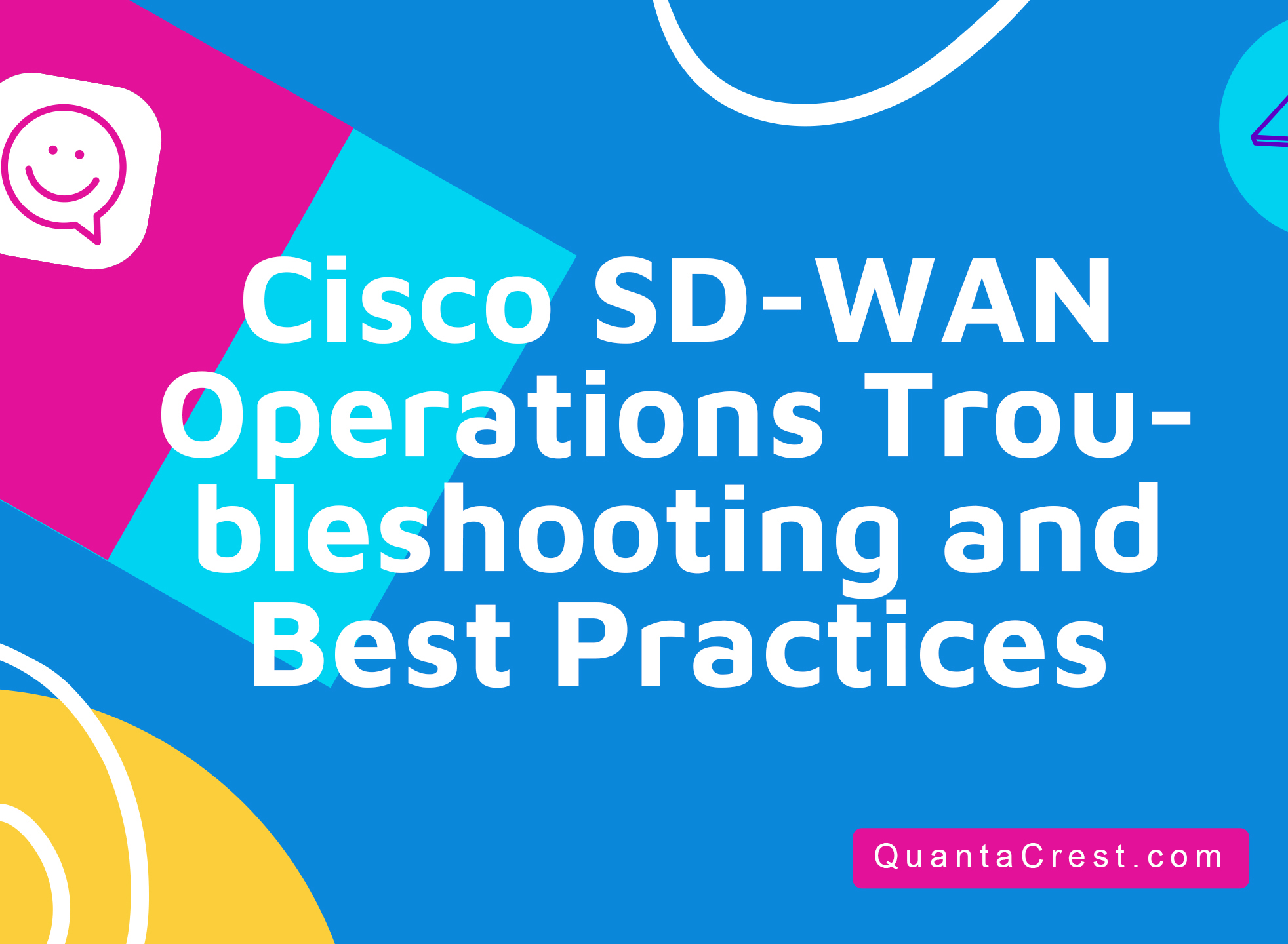Cisco SD-WAN Operations Troubleshooting and Best Practices
in CiscoAbout this course
Course Overview
SD-WAN: Advanced Operations & Troubleshooting Bootcamp focuses on the Cisco Software-Defined WAN (SD-WAN) solution. It is an overlay architecture that overcomes the biggest drawbacks of a traditional WAN. Students will be able to operate a Cisco SD-WAN over any transport (MPLS, Broadband, LTE, VSAT etc.) and provide troubleshooting, management, policy control and application visibility across the enterprise. This hands-on Course covers the Cisco SD-WAN product and contains extensive labs to reinforce the knowledge learned.
Target Audience
Individuals who are planning, implementing or administering a Cisco SD-WAN Solution.
Course Objectives
After completing this course you should be able to :
- Describe how to deploy SD-WAN
- Configure a SD-WAN environment
- Deploy Zero-Touch provisioning
- Implement SD-WAN security
- Configure SD-WAN policies
- Operate SD-WAN devices and software
- Troubleshoot a SD-WAN environment
Course Content
Cisco SD-WAN Introduction
- High-level Cisco SD-WAN Deployment models
- Application level SD-WAN solution
- Cisco SDWAN high availability solution
- Cisco SD-WAN Scalability
- Cisco SD-WAN Solution Benefits
Cisco SD-WAN Orchestration
- Introduction
- vManage NMS
- vSmart Controller
- vBond Orchestrator
- Controller Resiliency Architecture
Site Architecture and Deployment Models
- Site Capabilities
- vEdge Router
- vEdge form factors
Zero Touch Provisioning
- Overview
- User Input Required for the ZTP Automatic Authentication Process
- Authentication between the vBond Orchestrator and a vEdge Router
- Authentication between the vEdge Router and the vManage NMS
- Authentication between the vSmart Controller and the vEdge Router
Cisco SD-WAN Solution
- Overlay Management Protocol (OMP)
- Cisco SDWAN Circuit Aggregation Capabilities
- Secure Connectivity in Cisco SD-WAN
- Performance Tracking Mechanisms
- Application Discovery
- Dynamic Path Selection
- Performance Based Routing
- Dynamic Cloud Access
Operations Best Practices
- Config: Test Configuration Changes Before Committing
- NAT: Secure Routers Acting as NATs
- vEdge Routers: Connect to the Console Port
- vEdge Routers: Use the Poweroff Command
- Viptela Devices: Site ID Naming Conventions
- Viptela Devices: Using the System IP Address
- vManage NMS: Disaster Recovery
Application Monitoring
- vManage
- vAnalytics
- Ecosystem Partner Solutions
Troubleshooting Methods
- Remote Access
- Console Access
- LAN Interfaces
- WAN Interfaces
- Control Connections
General Troubleshooting
- Check Application-Aware Routing Traffic
- Collect Device Data To Send to Customer Support
- Monitor Alarms and Events
- Monitor TCP Optimization
- Ping a Viptela Device
- Run a Traceroute
- Simulate Flows
- Troubleshoot Cellular Interfaces
- Troubleshoot Device Bringup
- Troubleshoot WiFi Connnections
- Use Syslog Messages
- Tunnel Health
Troubleshooting: Data Plane Issues
- BFD Session Information
- Cflowd Information
- Data Policies
- DPI Information
- Symptom: Site Cannot Reach Applications in Datacenter
- Symptom: vManage Showing vEdge or Interface Down
- Symptom: Site-Wide Loss of Connectivity (Blackout)
- Symptom: Poor Application Performance (Brownout)
- Issue Severity Assessment
Troubleshooting: Routing Issues
- BGP Information
- Multicast Information
- OMP Information
- OSPF Information
- PIM Information
- Symptom: Some or All Routes Missing from vEdge Routing table
- Symptom: Data Traffic Using Suboptimal Path
- Symptom: Data Traffic Not Using All Transports
Application-Aware Routing
- Application Performance with CloudExpress Service
- Tunnel Latency Statistics
- Tunnel Loss Statistics
Interface Troubleshooting
- Reset an Interface
- All Interfaces
- ARP Table Entries
- Cellular Interface Information
- DHCP Server and Interface Information
- Interface MTU Information
- Management Interfaces
- VRRP Information
- WAN Interfaces
Network Operations
- Check Alarms and Events
- Check User Accounts and Permissions
- Deploy the Viptela Overlay Network
- Determine the Status of Network Sites
- Control Connections
- Data Connections
- Network Performance with vAnalytics Platform
- OMP Status
Security Certificate Troubleshooting
- Generate a Certificate
- Upload the vEdge Serial Number File
- Certificate
- CSR
Viptela Devices Maintenance
- Decommission a vEdge Cloud Router
- Determine the Status of a Network Device
- Locate a Viptela Device
- Migrate a Controller's Virtual Machine Using vMotion
- Reboot a Device
- Remove a vEdge Router's Serial Number from the vManage NMS
- Replace a vEdge Router
- Restore the vManage NMS
- Set Up User Accounts to Access Viptela Devices
- Validate or Invalidate a vEdge Router
- Software Versions Installed on a Device
- Status of a vBond Orchestrator
- Status of a vEdge Router
- Status of a vSmart Controller
Viptela Device Operation and Troubleshooting
- Determine Changes to a Configuration Template
- Determine Why a Device Rejects a Template
- Alarm Severity Levels
- Hardware Alarms
- Checking Alarms and Notifications
- LEDs
- Additional Information
- Restore a vEdge Router
- Remove vEdge Router Components
Working With Viptela Support
- Case Priority Levels and Response Times
- Information for Opening Cases
- Viptela Customer Support Portal
- Other Ways to Contact Support
Labs:
- Introduction to the Cisco SD-WAN
- Add vEdge to vManage Inventory
- Control-Plane Connectivity
- Overlay Network
- Zero-Touch Provisioning
- vManage Templates
- vManage Basic Policies
- Application Aware Policies
- Advanced Policies
- Analytics
- MultiTenant Mode and Tenants
- Troubleshooting Methods
- Troubleshooting Data Plane Issues
- Troubleshooting Routing Issues
- Best Practices
Course Prerequisites
Attendees should meet the following prerequisites:
- Familiarity with WAN Networks
Test Certification
Recommended as preparation for the following exams:
- There are no exams currently aligned to this course
Comments (0)






